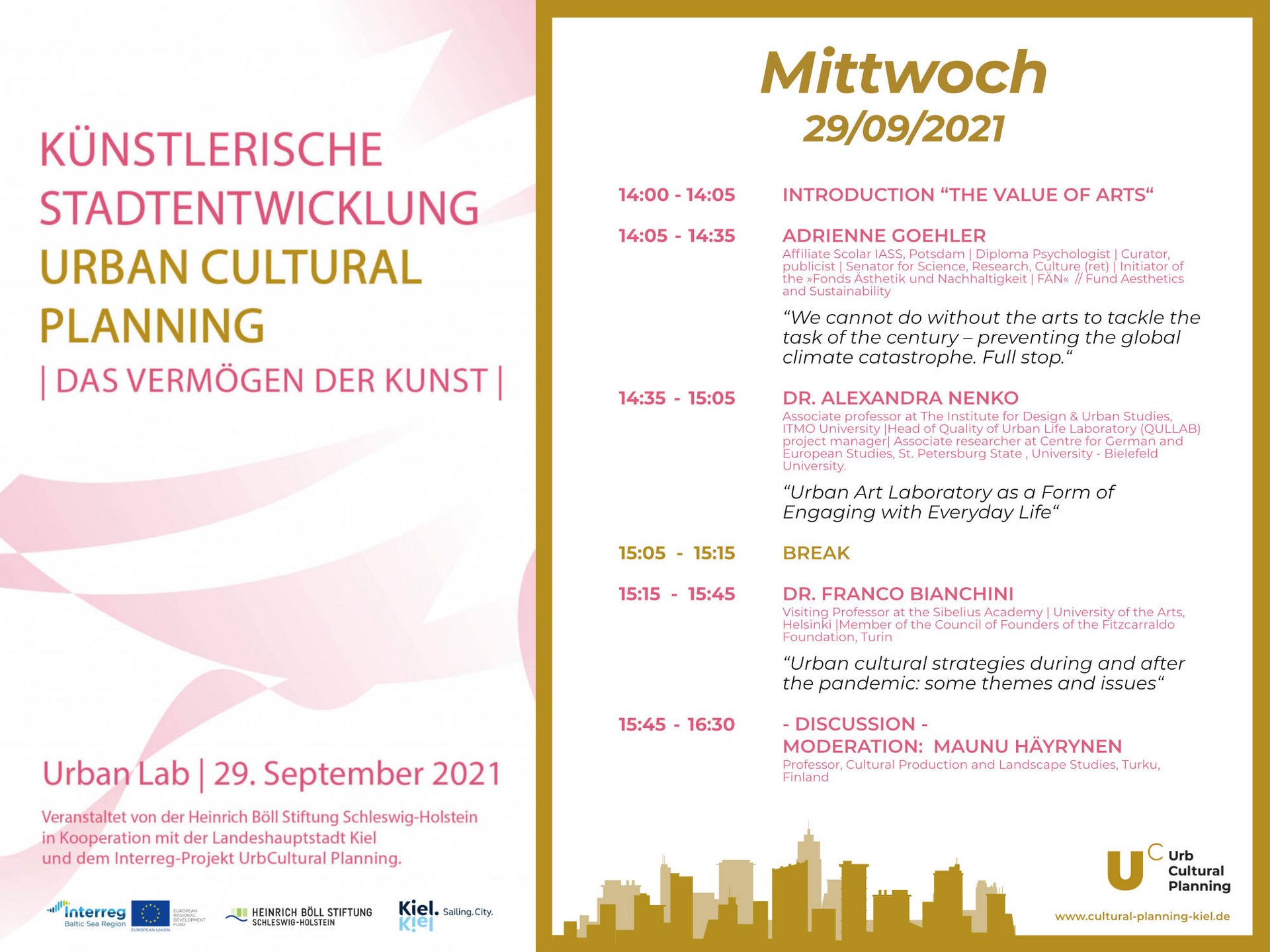

Urban Transformation through Art and Culture
Urban Transformation through Art and Culture
Urban Transformation through Art and Culture


Künstlerische Stadtentwicklung und Urban Cultural Planning
Am Mittwoch, den 29. September 2021 fand das zweite Kieler Urban Lab des UrbCulturalPlanning Projekts statt. Die Inhalte kreisten rund um künstlerische Stadtentwicklung und Urban Cultural Planning. Die Veranstaltung wird von der Heinrich Böll Stiftung Schleswig-Holstein in Kooperation mit der Landeshauptstadt Kiel und dem Interreg-Projekt UrbCultural Planning angeboten. Fokus des Urban Labs war die Rolle von Kunst und Kultur bei Transformationsprozessen von Städten:
Welche Rolle können Kunst und Kultur dabei spielen, welche Methoden wurden entwickelt und welche Strategien der Verbreitung dieser Methoden gibt es dazu bereits im Ostseeraum?
“Only when people are in a position to use their own creative potentials, which can be enhanced by an artistic imagination, will a change occur [...] Art can and should strive for an alternative that is not only aesthetically affirmative and productive but is also beneficial to all forms of life on our planet.“(Rasheed Araeen, Ecoaesthetics. A Manifesto for the Twenty First Century)

The talk will outline broad scenarios for the role of cultural actions and policies in European cities in the period during and after the COVID-19 pandemic. Predictions are difficult because the political situation is characterised by considerable confusion and uncertainty, with, for example, the coexistence of authoritarian and centralising tendencies with hyper-localism and decentralisation. I will then discuss some of the pandemic’s effects on the cultural sector in European cities. These include: the risk of decline of political status of, and support for, cultural policy; the crisis of small and medium-sized cultural organisations in particular; the growing risk of exclusion for people suffering from educational, cultural and economic poverty, and the rise of ‘arts and health’ and ‘cultural welfare’ objectives. The concluding parts of the talk will explore a selection of emerging themes and issues in urban cultural strategies, such as the debates about the need for a more ‘curative’ approach to culture-led urban regeneration, and the changing roles of European Capitals of Culture and other urban cultural mega-events.
Dr Franco Bianchini
Visiting Professor, Sibelius Academy, University of the Arts Helsinki
Associate Director, Centre for Cultural Value, UK (www.culturalvalue.org.uk)
Member of the Council of Founders and of the Board of Trustees, Fitzcarraldo Foundation, Turin (www.fitzcarraldo.it)
The presentation reflects upon the author’s curatorial experience of a multidisciplinary urban art laboratory conducted as a 1-month group process in St. Petersburg, Russia, entitled “25 lines” as a dedication to the streets (lines) of Vasilevsky Island where it took place. The main thesis of the lab is Guy Debord’s claim that “art should return to everyday life”. Through an autoethnographic lens, visual and text analysis of lab materials and personal interviews the presentation reveals the processuality of the lab, which was built as an intermixture of lectures and readings based on French critical urban theory and performative situated practices, which formed a common ground for 43 participants with different backgrounds, who then were led through a process of urban research to the final phase of creating artifacts representing the everydayness of the lines. The presentation shows different research techniques (e.g. drift, dialogue, rhythm analysis, mapping) used and tactics of appropriating the urban space performed by participants based on the context of the line itself and the personal knowledge and attitudes of the members. The presentation also discusses the emergent 25 mediums, which have translated sensual and conceptual experience of engagement with the lines in a variety of forms - games, installations, artbooks, alternative maps, video-guides, sculptures - and broadcasted the direct speech and materiality of the inhabitants’ personal worlds, places of memory, maps of movements, and other “documents” of everydayness. Finally the lab is considered as an educational and community making format linking art, urban studies and everyday life critical reflection.